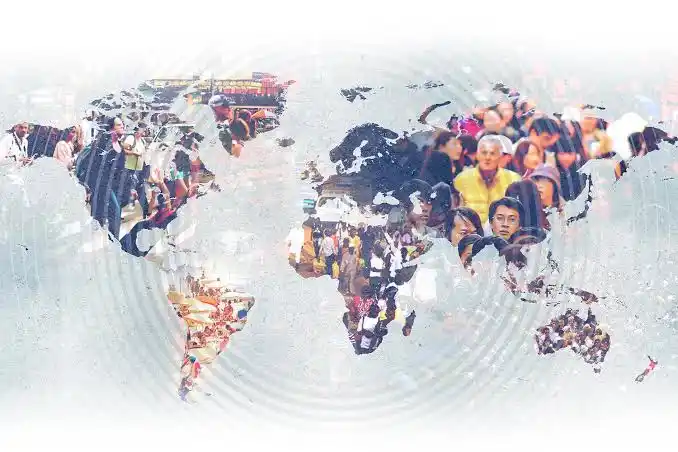The world is now 8 billion people

The world’s population have hit 8 billion according to UN estimates. This is a major milestone even though many parts of the world face plummeting growth rates and world leaders struggle to address pressing global issues like climate change, food security, aging populations and environmental destruction.
Over the past 25 years, the number of people on the planet has increased by one third, or 2.1 billion. In the last 25 years, almost all the growth happened in developing economies, mainly in Asia and Oceania (1.2 billion more people) and Africa (an additional 700 million individuals).
The milestone comes just 11 years after the human population reached 7 billion people and the continued growth can be attributed to extended life expectancies brought about through advances and developments in public health, sanitation and nutrition.
The human population could reach 8.5 billion by 2030, 9.7 billion by 2050 and peak at around 10.4 billion during the 2080s and remain at that level until 2100, the UN estimated.
Growth will not happen evenly across the planet, however, and the UN noted that more than half of the projected increase in global population up to 2050 will be concentrated in just eight countries: the Democratic Republic of the Congo (DRC), Egypt, Ethiopia, India, Nigeria, Pakistan, the Philippines and Tanzania.
Forecasts suggest other significant changes are on the horizon, the UN said, in particular increasing life expectancies—slated to rise from 72.98 in 2019 to 77.2 in 2050—and markedly older populations.
The proportion of people aged 65 will rise from 10% in 2022 to 16% in 2050, the UN estimates, with the number roughly double that of children under 5 and around the same as those under 12.
The demographic changes present major challenges to nations and the UN urged countries with aging populations to adapt their public programs to address the issue, including improving the sustainability of social security and pension systems, establishing universal health care and setting up long-term care systems.
Contrast
Though the human population is still climbing, growth is slowing. Humanity passed the 7 billion milestone in 2011 and the UN estimates it will not reach 9 billion until 2037, 15 years from now.
Birth rates have fallen across much of the world—numerous factors can help explain this, including increased access to contraception, the aging population, better education and progress protecting the rights of women and children—and in many countries, fertility rates have already fallen well below what is needed to maintain the size of the population.
Currently, the UN estimates around two-thirds of the global population live in a country of area where birth rates aren’t sufficient to maintain the population size and some 61 countries or areas are projected to decrease by 1% or more by 2050 (emigration, as well as falling fertility rates, is also a factor here).
By 2050, Bulgaria, Latvia, Lithuania, Serbia and Ukraine are all projected to face losses of 20% or more, the UN said.
READ ALSO: Check out countries of the world compared by major metrics
What to watch for
India is slated to overtake China as the world’s most populous country at some point during 2023, the UN estimated. India and China are currently home to around 1.39 billion and 1.41 billion people, respectively, each more than four times the U.S., the world’s third most populous country.
The UN projects India and China will remain the world’s first and second largest population hubs, though China is expected to face a precipitous drop in its population, halving its current value by the end of the century. Countries in sub-Saharan Africa, meanwhile, are expected to keep growing throughout 2100.
Surprising fact
By 2050, the U.S. will no longer be the world’s third most populous country, the UN estimates. It will sit in fourth place behind Nigeria with around 375 million people, the agency projected. By 2080, it will have been overtaken by Pakistan and the UN estimates that by 2100 it will sit at sixth place behind the DRC.
The full list
According to UN models, the world’s ten most populous countries will change over the course of the century.
2022
- China
- India
- U.S.
- Indonesia
- Pakistan
- Nigeria
- Brazil
- Bangladesh
- Russia
- Mexico
2050
- India
- China
- Nigeria
- U.S.
- Pakistan
- Indonesia
- Brazil
- DRC
- Ethiopia
- Bangladesh
2100
- India
- China
- Nigeria
- Pakistan
- DRC
- U.S.
- Ethiopia
- Indonesia
- Tanzania
- Egypt
What we don’t know
It is impossible to know precisely how many people are alive at any given moment. The UN’s figures are based on models designed using census and other demographic data. It’s possible the world’s population passed 8 billion a year or two ago or will do so at some point over the next few years.
Most forecasts suggest the global population will decline in the latter half of the century, though the further out forecasts go the less reliable their predictions are.
Experts don’t agree on the upper bounds Earth places on humanity’s existence, but many place sustainable limits many billions below current levels if our patterns of consumption and resource are to remain the same.
Source: Forbes
READ ALSO: Ambassador Alima Mahama joins Congresswoman Ilhan Omar in a panel on creating a self-sufficient Africa
Abeeb Lekan Sodiq is a Managing Editor & Writer at theafricandream.net. He is as well a Graphics Designer and also known as Arakunrin Lekan.



